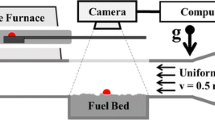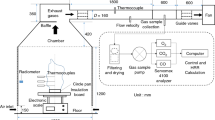Abstract
Activated carbons are widely used in the iodine adsorbers in nuclear plants, but little information about their combustibility is available for fire engineers. Series of TGA experiments were conducted for activated carbons, charcoal and XPS foam. The results show that the activated carbons oxidize strongly in air atmosphere but little in N2 atmosphere. The calculated activation energies of the wood AC, anthracite AC and coconut shell AC are, respectively, 100.56, 96.34 and 91.00 kJ mol−1, which are larger than that of the XPS foam, 55.95 kJ mol−1. However, the calculated activation energies of impregnated coconut shell activated carbon is 48.60 kJ mol−1, which is smaller than that of XPS foam. A new parameter, A12, is introduced to describe the amount of evaporative mass fraction during the fast pyrolysis stage. Additionally, the (Tp, DTGp) map and quarter division method is introduced to compare fire hazard of different materials. Finally, a quantitative fire hazard evaluation model is developed based on four important parameters: E, DTGp, Tp and A12. The calculated Relative Fire Safety Factors by this model for wood AC, anthracite AC, coconut shell AC, impregnated coconut shell activated carbon, charcoal and XPS foam are 1.49, 1.91, 1.51, 1.37 and 1.0, respectively.







Similar content being viewed by others
References
Lu L, Di ZG. The conflagration risk of the nuclear power plant and study of firefighting. Urgent Rescue. 2012;2:49–52.
GB 12268-2012: List of dangerous goods.
International Maritime Dangerous Goods (IMDG) Code (IJ200E), Volume 2: Dangerous goods lists, special provisions and exceptions, 2014; International Maritime Organization.
Tachibana E, Ikuo A. Application technology of activated carbons (Chinese translation version). Nanjing: Southeast University Press; 2002.
Wang N. Study on spontaneous combustion risk of activated carbon. PhD dissertation: Dalian University of Technology, Dalian; 2012.
Buettner LC, Leduc CA, Glover G. Instantaneous ignition of activated carbon. Ind Eng Chem Res. 2014;53:15793–7.
Cameron A, MacDowall JD. Self heating of commercial powered activated carbons. J Appl Chem Biotechnol. 1972;22:1007–8.
So JY, Cho HR. Thermal characteristics of spent activated carbon generated from air cleaning units in korean nuclear power plants. Nucl Eng Technol. 2017;49(4):873–80.
Shawabkeh RA, Aslam Z, Hussien IA. Thermochemical treatment of fly ash for synthesis of mesoporous activated carbon. J Therm Anal Calorim. 2015;122(3):1191–201.
Lam SS, Liew RK, Wong YM, Yek PNY, Ma NL, Lee CL, Chase HA. Microwave-assisted pyrolysis with chemical activation, an innovative method to convert orange peel into activated carbon with improved properties as dye adsorbent. J Clean Prod. 2017;162:1376–87.
Jayabalan T, Pre P, Hequet V, Le Cloirec P. Statistical quantification of the influence of material properties on the oxidation and ignition of activated carbons. Adsorption. 2008;14:679–86.
Jayabalan T, Pre P, Hequet V, Rouzaud JN, Le Cloirec P. Material properties influencing the oxidation and ignition reactivity of activated carbons: thermal analysis, HRTEM study, and statistical modeling. Energ Fuel. 2009;23:4051–8.
Kissinger HE. Reaction kinetics in differential thermal analysis. Anal Chem. 1957;19:1702–6.
Yang Y, Xie QY, Tang XY. Trace analyses of flame-retardant in pyrolysis of XPS foams and its revelation for flame-retardant optimization. J Therm Anal Calorim. 2018;132(3):1893–8.
Hammarstrom JL, Sacco A. Investigation of deactivation mechanisms of ASC whetlerite charcoal. J Catal. 1988;112:267–81.
Szekely T, Varhegyi G, Till F. Determination and use of second derivative thermogravimetric function (DDTG) and calculation of kinetic constants of some decomposition reaction types. J Therm Anal. 1973;5:2–3.
Chen ZH, Zhu QJ, Wang X, Xiao B, Liu SM. Pyrolysis behaviors and kinetic studies on Eucalyptus residues using thermogravimetric analysis. Energ Convers and Manag. 2015;105:251–9.
Acknowledgements
This work was supported by the National Natural Science Foundation of China (51476157), National Key R&D Program of China (2017YFC0805901) and the Fundamental Research Funds for the Central Universities (WK2320000041). The authors thankfully acknowledge all these supports.
Author information
Authors and Affiliations
Corresponding author
Additional information
Publisher's Note
Springer Nature remains neutral with regard to jurisdictional claims in published maps and institutional affiliations.
Rights and permissions
About this article
Cite this article
Lei, Q., Xie, Q. & Ding, Y. Fire hazard evaluation of activated carbons. J Therm Anal Calorim 139, 441–449 (2020). https://doi.org/10.1007/s10973-019-08417-z
Received:
Accepted:
Published:
Issue Date:
DOI: https://doi.org/10.1007/s10973-019-08417-z




